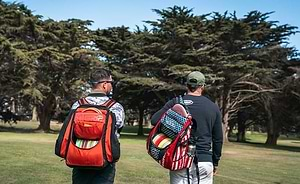You Missed the Mando. Now What?
TOC
Table of Contents
Many disc golf holes have mandatory trees or light poles. We just call them “mandos.” A mando on a disc golf course means that your throw must travel around one specific side of that marked mandatory object, according to standard PDGA rules. On the playing surface, you’ll find left mandos, right mandos, top mandos and bottom mandos. In addition to the single mandatory, you’ll even find double-mandos which force you to go between two specific trees and the rare triple-mando where there is a bar, branch or rope across the top of two mando markers and you must stay under or above it as indicated.

A good example of a triple-mando is found on our home course of Winthrop Gold, host to the United States Disc Golf Championship. Hole 7 is a triple-mando through a bamboo gate. It would be a short and easy hole without that gate, but the mando makes it a whole lot more interesting. Then we have the new holes 3 and 4 added last year, which both feature double-mandos. The two sets of double-mandatory trees on hole 4 make the fairway on a relatively short tunnel shot that much more intimidating. These are just a few of many famous mandos on our championship-level disc golf course!
Why Are There Mandatories?
Mandos are added on courses for two primary reasons:
- Safety—Many mandatory lines are determined by the layout of the disc golf course itself and the Tournament Director (TD). Since a majority of disc golf courses are in public parks and shared-use spaces, mandos are used to keep people from throwing their golf disc over parking lots, public roads, playgrounds, picnic areas or other disc golf tee pads and greens during casual or tournament play.
- Challenge—Some mandos are added to make simple holes a little less simple. Hole 7 at Winthrop Gold is a perfect example. Without the triple-mando gate, it would be a short, wide open shot that you could attack that hole from any angle. Pros playing the USDGC would especially be able to shred that hole for easy birdies—and ace runs—all day long and it’s not that interesting to play or watch. The mando gate adds a lot more challenge and limits the types of throws players can use to hit the necessary gap and get a clean look at birdie.
Even a standard single-mando left or right will typically add a little challenge and intimidation as you want to hit the correct side of the mandatory object. That tree may not even come into play that much, but somehow it’s much more a threat when there’s a mandatory marker on it.
So, it’s easy to understand WHY there are mandos in disc golf. Now, let’s talk about HOW to deal with them.
Understanding Mando Rules

First, you’ll want to do your best to hit the necessary line and steer clear of making the mandatory. Play it extra safe if you have to. If there’s a double-mando, then that’s usually not as easy because you have a more specific gap to hit. Most mandatory objects are pretty well defined, but there are also confusing ones where they are on a tree with many branches. There is often confusion when someone throw their disc through the middle of the branches of that tree.
If this happens, you can consult with your Tournament Director if in competitive play, or you work with your card mates to make a ruling. In most cases, the mando is based on the trunk of the tree or the specific branch where the mando arrow sign, spray paint mark or tape is applied. If you are unsure of the official rules and you are playing in a tournament round, declare a provisional throw and play out the hole as if you both made and missed the mando. Write both scores on the scorecard for now and then get a ruling from an official after your round. If you throw your disc over the top of the mandatory object, again it’s up to you and your card mates to determine if you cleared the proper side of the mandatory line.
What if I Miss the Mando?
To have missed a mandatory means that your disc has traveled past the object marked as a mando on the wrong side. If the mando was to the left of a tree and you throw it past the tree on the right side, then you have missed your mando. If you are not yet past the mandatory, then you have options that we will explain a little later. If you have clearly missed the mando, then it’s not the end of the world. We’ve all done it many, many times. It sucks to take a penalty stroke, but it is what it is and you move on to try and achieve your best score from there.
Your course of action after missing a mando will depend on the disc golf course setup and specific rules, if in a tournament. All mandos in a PDGA-sanctioned tournament should have a marked drop zone to throw your next shot from. In some cases, the rules will specify that you must re-tee after missing a certain mando. The drop zone rulings aren’t always as clear in casual play. If there is no marked drop zone, you can use your best judgment. You can usually just drop next to the mando tree on the correct side and then throw from there with your stroke penalty. A double-mando drop zone will usually be somewhere in between the two marked objects. You will assess one penalty stroke for any missed mando added to your final score for the round.
What if I My Disc is Still Short of the Mando?
If your disc has yet to pass the mandatory line, then you will take your next shot from wherever you lie without a penalty throw. However, you will still need to make it around the correct side of the mando. This often requires some creativity or you might have to take your medicine and toss a putter back to the middle of the fairway. If you miss the mando on your next shot, then proceed to the drop zone.
If you are really out of position off the fairway or stuck in a tough lie, you always have the option to return to the spot of your previous lie, take a penalty stroke and rethrow. Even if you play from your previous throw, you’ll still have the mando to deal with again on your next shot, but it may be your best option if you are in a super difficult spot.
Determining Stance Angle Near a Mando
One important PDGA rule that disc golfers often overlook is how to line up their stance when they are near a mando. If your disc is short of the mando but on the the wrong side of the mando tree trunk, you cannot just straddle out and basically hug the tree to throw on the correct side. You must line up your next shot and stance based on the location of the mando itself. This is your new mandatory line of play to clear the mando. Normally, you line up your shot and mark your disc in a direct line between you and the basket. When off to the wrong side of a mando, you essentially draw a straight line as if that mando tree/pole is the basket. Then, place your maker disc and take your next stance accordingly.
Mandatories are a fun and sometimes frustrating part of our sport, and they are becoming more and more popular as disc golf course designers look to add challenge and intrigue to the layouts. Sometimes they are necessary for safety. Sometimes they are just there to be diabolical. It’s just important to know how to properly play by the rules and count your score if you happen to miss a mando.
Personalized Disc Recommendations
Just answer a few questions and we’ll send you personalized recommendations within 24 hours.
GET PRO TIPS


